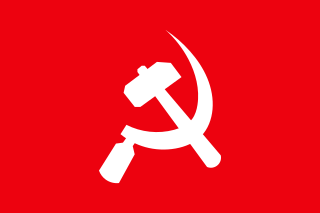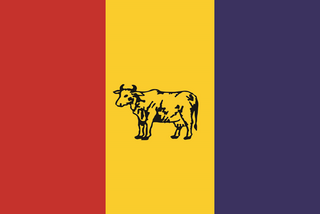
The Nepali Congress is a social-democratic political party in Nepal. It is the largest opposition party in the House of Representatives and the National Assembly.
The Communist Party of Nepal was founded on September 15, 1949. CPN was formed to struggle against the autocratic Rana regime, feudalism and imperialism. The founding general secretary was Pushpa Lal Shrestha. Other members are Nar Bahadur Karmacharya, Niranjan Govinda Baidhya, and Narayan Bilas Joshi.

Pushpa Kamal Dahal, commonly known by his nom de guerrePrachanda, is a Nepalese politician, Chairman of the Nepal Communist Party and twice Prime Minister of Nepal, from 2008 to 2009 and from 2016 to 2017.

The Communist Party of Nepal was one of the two major communist parties in Nepal. The party was formed in January 1991 with the unification of the Communist Party of Nepal (Marxist) and the Communist Party of Nepal (Marxist–Leninist). It has led four governments: from 1994 to 1995 under Man Mohan Adhikari, from 2009 to 2011 under Madhav Kumar Nepal, in 2011 under Jhala Nath Khanal, and from 2015 to 2016 under KP Sharma Oli. The party was also a junior partner in five coalition governments: in 1997 under Lokendra Bahadur Chand, from 1998 to 1999 under Girija Prasad Koirala, from 2008 to 2009 under Pushpa Kamal Dahal, from 2011 to 2013 under Baburam Bhattarai, and from 2014 to 2015 under Sushil Koirala. It dissolved on 17 May 2018 to make way for the Nepal Communist Party in a merger with the Communist Party of Nepal.

All Nepal Communist Revolutionary Coordination Committee (Marxist–Leninist) was a revolutionary communist movement formed in Nepal in 1975. ANCRCC( ML) had its roots in Jhapa District Committee of the Communist Party of Nepal as well as the Morang-based Nepal Revolutionary Organisation (Marxist-Leninist). In Jhapa armed struggle had been developed, inspired by the Naxalite movement in India.

The Rastriya Prajatantra Party is a royalist political party in Nepal. It was formed by former Prime Ministers, Surya Bahadur Thapa and Lokendra Bahadur Chand. The party has had two Prime Ministers, Thapa and Chand, serving two terms each since the end of the Rastriya Panchayat.

Communist Party of Nepal (Manandhar) was a splinter group of the Communist Party of Nepal (Rayamjhi) formed in 1979, in the backdrop of the popular movement that surged in that year. The party was led by Bishnu Bahadur Manandhar. CPN (Manandhar) was clearly pro-Soviet Union.

Communist Party of Nepal , a communist splinter group led by Pushpa Lal Shrestha. The party emerged in 1968, as Pushpa Lal organized a separate party congress in Gorakhpur, India. After the 1962 convention of the radical communist sector, which constituted the separate Communist Party of Nepal, Pushpal Lal was supposed to have shared the leadership of the party together with Tulsi Lal Amatya. But the cooperation between the two had broken down. A large section of the party cadres followed Pushpa Lal in forming a new party. Thus, for a few years Pushpa Lal's party was the major communist group in Nepal. The party was politically close to the Communist Party of India (Marxist). Pushpa Lal's party upheld the line of 'People's Democracy'.

Communist Party of Nepal, also referred to as Communist Party of Nepal (Amatya) was a communist party in Nepal. It emerged from a split in the original Communist Party of Nepal in 1962. The Communist Party of Nepal had been ravaged by internal conflicts, due to the Sino-Soviet split and differences of how to relate to political changes in the country.

Communist Party of Nepal (Soviet), was an underground political party in Nepal. It was founded 1978 by the All Nepal Communist Revolutionary Coordination Committee (Marxist-Leninist). The founding congress was held December 26, 1978-January 1, 1979. The first general secretary of CPN(ML) was C.P. Mainali.

Communist Party of Nepal (Burma), initially known simply as Communist Party of Nepal or Communist Party of Nepal , was a communist party in Nepal. The party emerged from a split in the original Communist Party of Nepal in 1962, representing the pro-Soviet sector of the party. Its main leader until 1983 was Keshar Jung Rayamajhi, who had been the general secretary of the original CPN.

Nepal RatnaMadan Kumar Bhandari commonly known as Madan Bhandari, was a popular Nepali political leader belonging to the Communist Party of Nepal, a democratic communist party in Nepal. He defeated the incumbent Prime Minister Krishna Prasad Bhattarai in the 1991 general election. Known for his charismatic style, Bhandari had propounded the popular communist principle or thought People's Multiparty Democracy. He is widely regarded for peaking the Nepal's communist movement to a greater height. He died in a mysterious jeep accident in Dasdhunga, Chitwan, in 1993 of which the cause of death has not yet revealed. It has been dubbed as an unsolved murder.
Barre Sangarsh Samuha was a communist faction in Barre, Nepal. The group emerged in the early 1980s, after breaking off from the Communist Party of Nepal. It subsequently merged into the Communist Party of Nepal (Marxist-Leninist).
Sandesh Samuha was a communist group in Nepal. It emerged as the Dang District Committee of the Communist Party of Nepal separated itself from its mother party.

Keshar Jung Rayamajhi was a Nepalese politician. He was a leading figure in the communist movement in the country, but later turned into a royalist. Rayamajhi hails from a landlord Chhetri family in Tansen, Palpa district.
Nara Bahadur Karmacharya is a Nepalese communist politician, belonging to Communist Party of Nepal. Karmacharya is one of the most senior political leaders of the communist movement in Nepal being the only surviving founding member of the Communist Party of Nepal, which had been born in 1949.

Khadga Prasad Sharma Oli , more commonly known as KP Sharma Oli, is a Nepalese politician and the current Prime Minister of Nepal. Oli previously served as prime minister from 11 October 2015 to 3 August 2016 and was the first elected prime minister under the newly adopted Constitution of Nepal.
The Communist Party of Nepal was founded in Calcutta, India, on September 15, 1949.

Nepal Federal Socialist Party is a political party in Nepal. The party was formed on 17 December 2016 by Mohammad Rizwan Ansari.
Communism in Nepal traces its roots back to the pro-democracy movement of 1951, and the subsequent overthrow of the autocratic Rana regime and the establishment of democracy in Nepal. The communist movement in Nepal has split into factions multiple times and multiple factions have come together into a single fold at times as well. It has a history of getting banned from open political discourse; as well as multiple instances of embracing guerrilla insurgency, most notably, the Maoist insurgency in the 1990s and early 2000s that led to the Nepalese civil war, claiming at least 15,000 lives. After the Maoists and other main political parties formed a united coalition, launching a successful peaceful civil resistance against the dictatorial coup d'etat by the monarchy, which resulted in the abolition of monarchy and drafting of a new constitution affirming Nepal as a secular, federal, democratic republic striving towards democratic socialism, the two main communist parties of Nepal contested the first election according to the new constitution as a coalition, eventually leading to the unification of two parties with a strong majority in the federal parliament as well as six out of seven provinces of Nepal.









